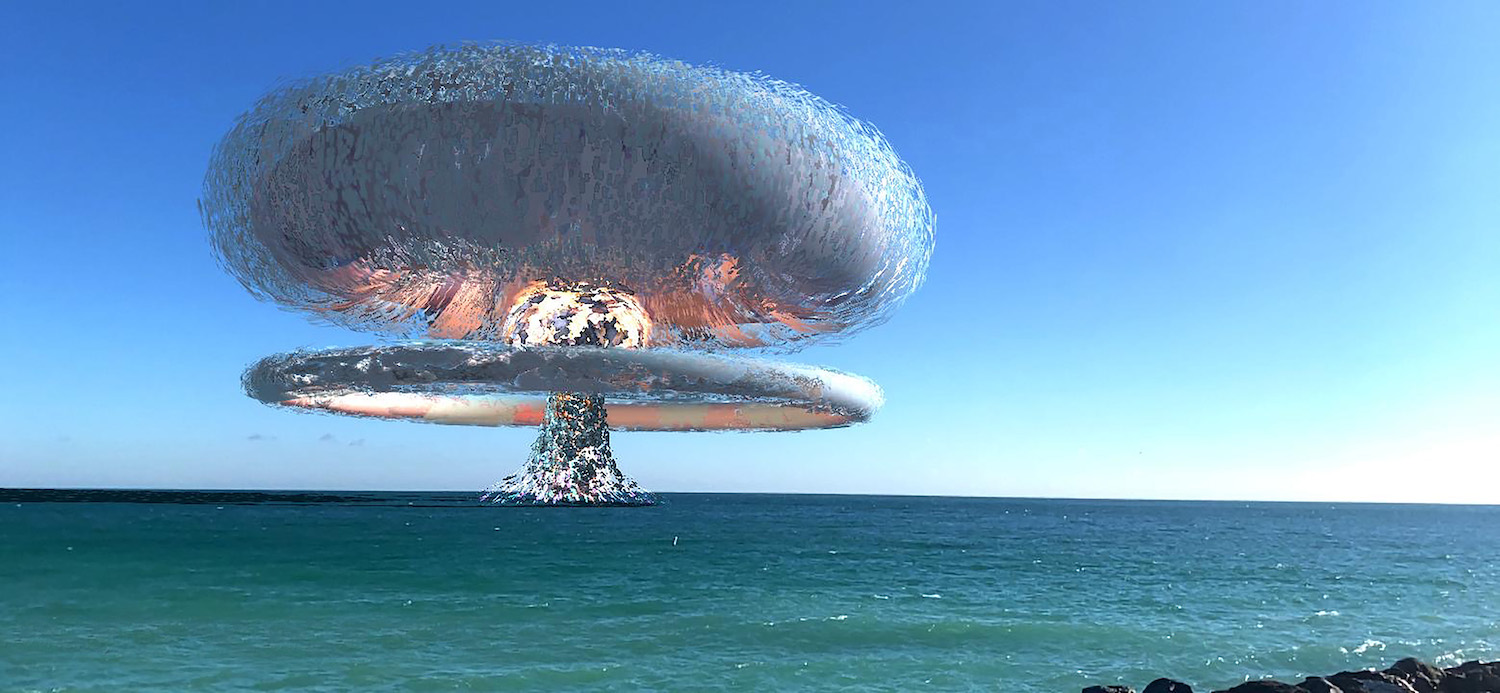In 2017, my friend—artist/curator Nancy Baker Cahill—invited me to see the art she was creating using virtual reality technology. Until that point, I knew Nancy to make ambitious drawings and otherworldly videos depicting abject, flesh-like topologies; works articulating her long-standing interests in questions of physical embodiment. She made real drawings with real materials—like carbon, pigment and paper—stuff you can get your hands on. So, it was a bit of a surprise she had moved into using complicated state-of-the-art technology, leaving the “meat space” for a virtual tabula rasa.
“Sometimes people get motion sickness. So let me know if you feel like you’re going to puke,” Nancy said after fitting my head with virtual reality (VR) goggles. “You ready?”
BOOM. Suddenly a maelstrom of black and gray shards was moving around me, in me, and through me, rocking in a coded breeze of zeros and ones. I remember screaming something apropos like, “HOLY SHIT!” I thought I was ready. I wasn’t. VR is definitively fucking awesome.
Nancy eventually helped me zoom out to see her drawing in its entirety: an empty circle in a limitless expanse surrounded by sharp, short marks created using one-of-a-kind brushes she developed herself to maintain a sort of creative independence and not rely on someone else’s tools. She pointed out that the work was a 3D digital iteration of one of her Hollowpoint graphite-on-paper drawings, which hung on the wall nearby—an essential fact that tied this virtual work to its analog doppelganger. As Nancy loaded more works from this series, I found myself wading through immersive abstractions resembling falling comets, swirling hurricanes and teeming undergrowth. When I left her studio that day, I knew Nancy had discovered a transformative way to expand on what she had been doing all along: creating things that make your body see itself and the world anew, challenging the limits of perception.
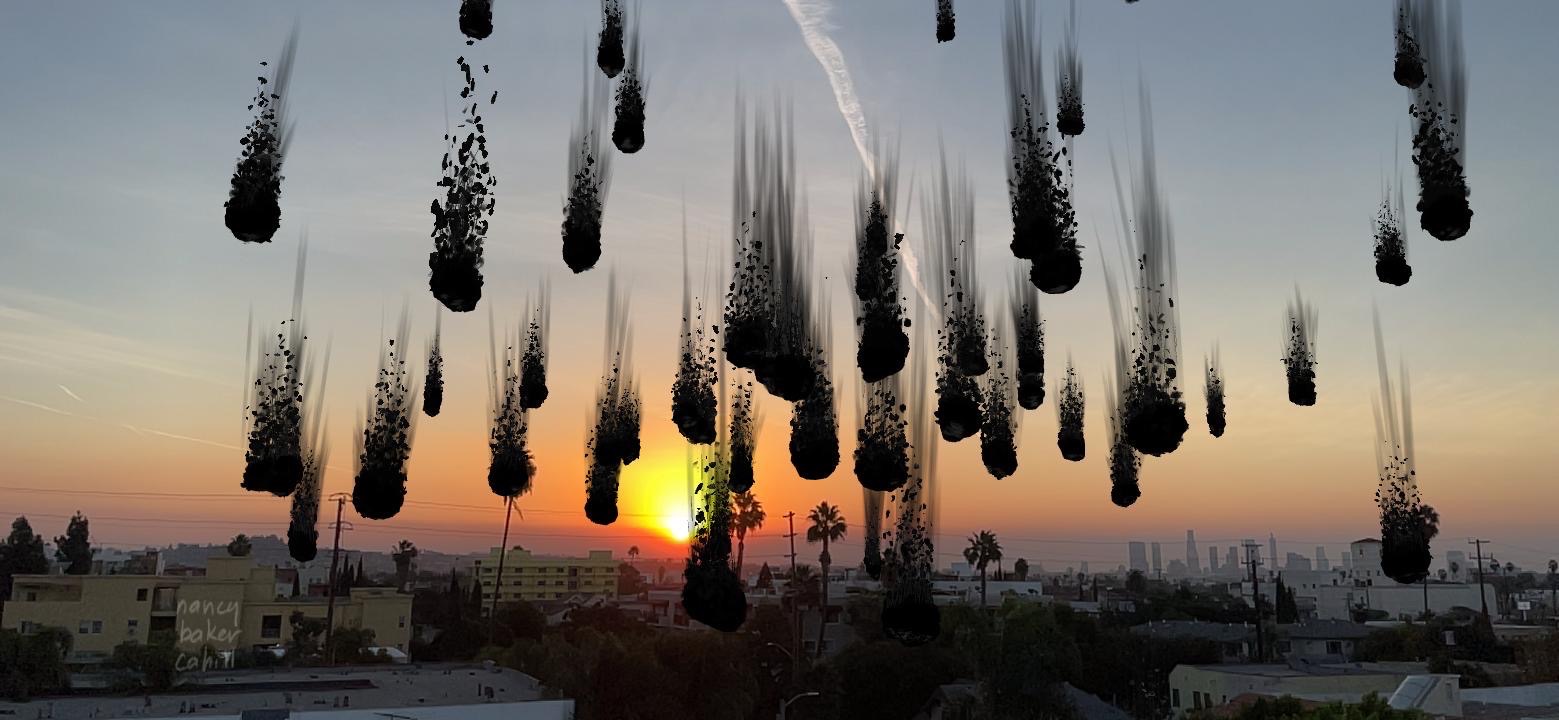
Hollow Point 103 AR, 2017, augmented reality
To experience Baker Cahill‘s fully immersive digital worlds—or any VR work for that matter—you need access to prohibitively expensive equipment. To get around this barrier, Baker Cahill worked with Drive Studios to create and release the free 4th Wall app in 2018. The app uses augmented reality (AR) to place digital representations of artworks in the “real world.” All you need is a smartphone or tablet with a cellular connection to experience her work—and the works of other artists—in the space around you. The app lets you scale her drawings to fit in the palm of your hand or consume the entire room. There’s a tangible surrealness that accompanies seeing something through your phone’s camera, which usually shows you what is right in front of you but instead relays something that is not and cannot be physically “real.” It’s a sensation that makes one question reality. When I spoke recently with Baker Cahill, she noted that her AR explorations have caused her to ask: “How can we as artists use this technology not just playfully but also harness its subversive potential to trigger poignant conversations about responsibility?” One of the ways the 4th Wall app helps answer this question is by acting as a platform for public art, allowing users to experience AR works in specific, geolocated spaces, placing their bodies in proximity to an artwork that is digitally present yet physically invisible.
One AR piece that utilizes this there/not there dichotomy to bring the past into the present is Holy Family Spiritual Church by Chandra McCormick, which consists of a singular black-and-white photograph of Black women gathered in prayer, dressed in white veils and gowns. The work was realized in 2019 as part of “Battlegrounds,” an exhibition Baker Cahill co-curated with Jesse Damiani. For the exhibition, the pair worked with 24 artists to create 31 AR works in locations in and around New Orleans. Floating like a phantom billboard in a vacant lot in the Lower Ninth Ward, McCormick’s AR work testifies to the historical importance of churches in the area that were once helmed by Black female leaders. Systemic racism and encroaching gentrification may have caused these sites to disappear over time, but McCormick’s AR piece reanimates this past in the here-and-now. Her digital image functions better than a billboard because its virtual existence is nearly impervious to the ravages of time, putting on a different plane of temporal cognition. Once you see the work, it is always there; its AR presence fixed in memory and digital code. “It relates to the “territory of consciousness,” Baker Cahill notes. “That’s the subversive potential of AR.”
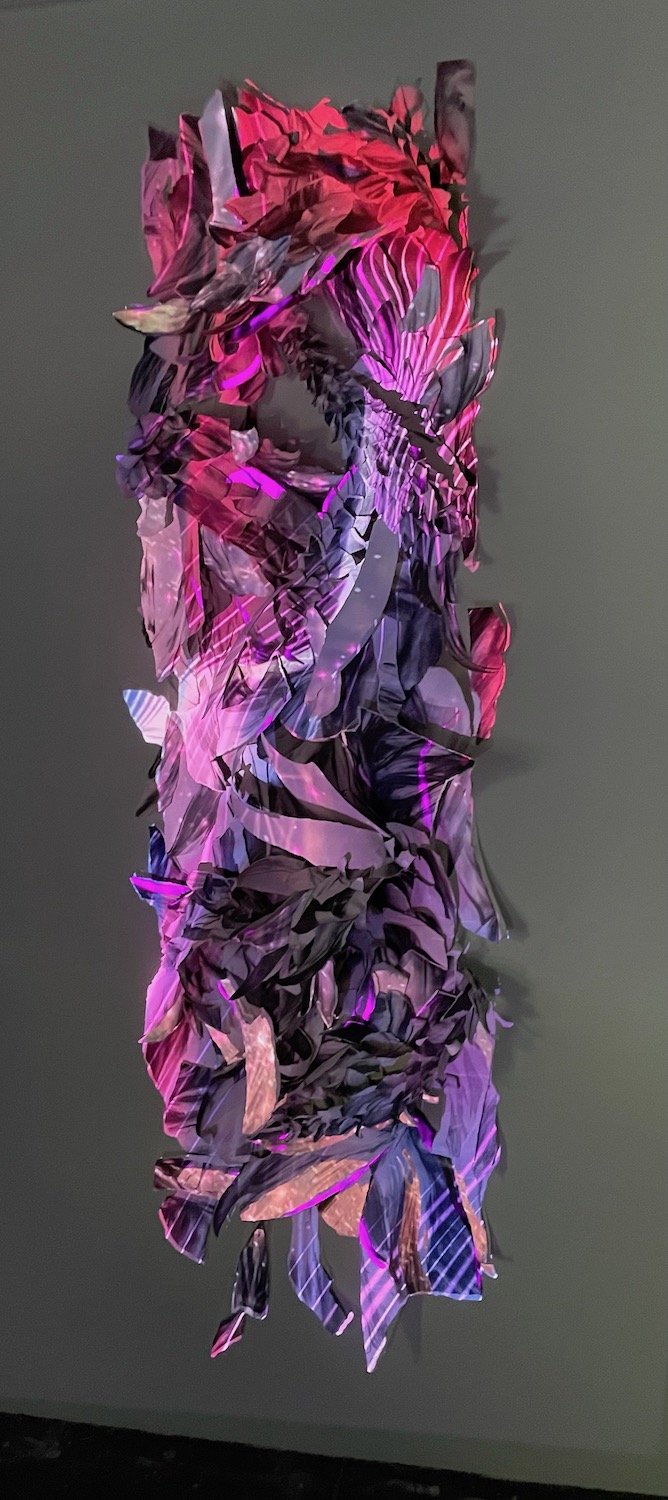
Thoughtshape, 2021, projection mapped sculpture
In addition to developing a robust curatorial practice with projects like “Battlegrounds,” Baker Cahill creates her own public artworks using VR drawings and the 4th Wall app’s AR environment to address complex social and political issues. On July 4, 2020, she launched Liberty Bell, geolocating an undulating VR animation, what she describes as, “a writhing, seething mess of threads, something that crawls out of its own skin,” near significant landmarks in six US cities: Boston, Washington, Charleston, SC, Rockaway, NY, Selma, AL and, of course, Philadelphia. Accompanied by a raucous soundtrack created by Baker Cahill’s longtime collaborator Anna Luisa Petrisko, the tolling bell embodies the turbulent political discourse of an election year and the fraying state of American democracy. It’s a fitting metaphor for the burgeoning metaverse.
Many of Baker Cahill‘s other public works employ animated representations of visual catastrophes near sites impacted by climate change. For the 2019 Desert X Biennial, she placed two of her signature pieces in the Coachella Valley, one among the area’s sprawling wind turbines, the other over the Salton Sea, spatially and conceptually tying the two locations together, juxtaposing sites of renewable energy with the casualties of environmental degradation. In Mushroom Cloud, exhibited in Miami in late 2021, she created a cataclysmic explosion over the Atlantic that turns into a network of mycelial nodes, connections in a seemingly endless web blanketing the sky. The piece, which also engaged avenues of participation and exchange through NFTs and blockchain-enabled contracts, exists as a split-second reference to the slow-moving climate catastrophe and a hopeful reminder of the complex yet unseen linkages that connect life on the planet.
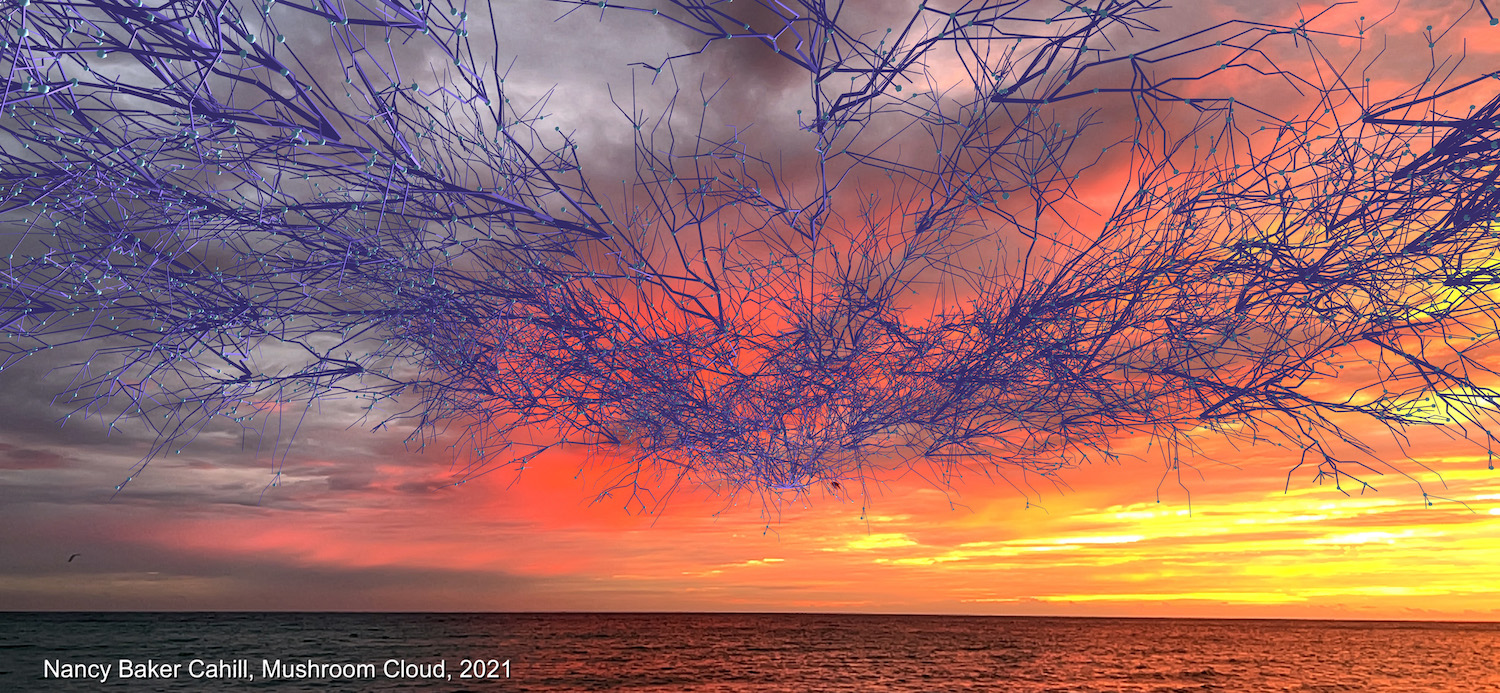
Mushroom Cloud Mycelia 1, 2021, augmented reality land art
Currently, Baker Cahill is preparing her most ambitious AR public works to date for the 2022 Elevation Biennial in St. Moritz and Gstaad, Switzerland, where she will unveil two animated drawings that engage in a call-and-response between the two locations. In all her works about climate change, she provides a brief but powerful opportunity for contemplation and connection, shrinking the sublime terror of impending disaster into something observable and psychologically understandable. Her work is experienced collectively in public, compelling her audience to engage in discussions with other people about what sorts of “realities” must manifest to avert total ecological collapse.
In addition to her public works, Baker Cahill currently develops projects for traditional gallery spaces and emerging online venues dedicated to showcasing and selling NFTs. Much of this work results from complicated processes engaging the conceptual and perceptual limitations of material space and the digital codes that govern the creation and transmission of information. It’s complex stuff that always results in visually intoxicating outcomes. She begins this piece by making intricate drawings (which form the foundation of her practice) then tears apart and transforms these works on paper into dynamic sculptural objects that emerge from the wall. After this, she documents these sculptures and brings them into the computer, translating them into 3D digital objects, which she then turns into moving animations. Finally, she reinserts these animations back into the “real world” as videos, limited edition prints, or as illuminated projections thrown onto her original paper sculptures. “I’m asking, what is sculpture in digital space?” Baker Cahill tells me, adding, “The work is a celebration of hybridity. I’m charting or indexing what gets lost and gained through a series of mutations and transformations.”
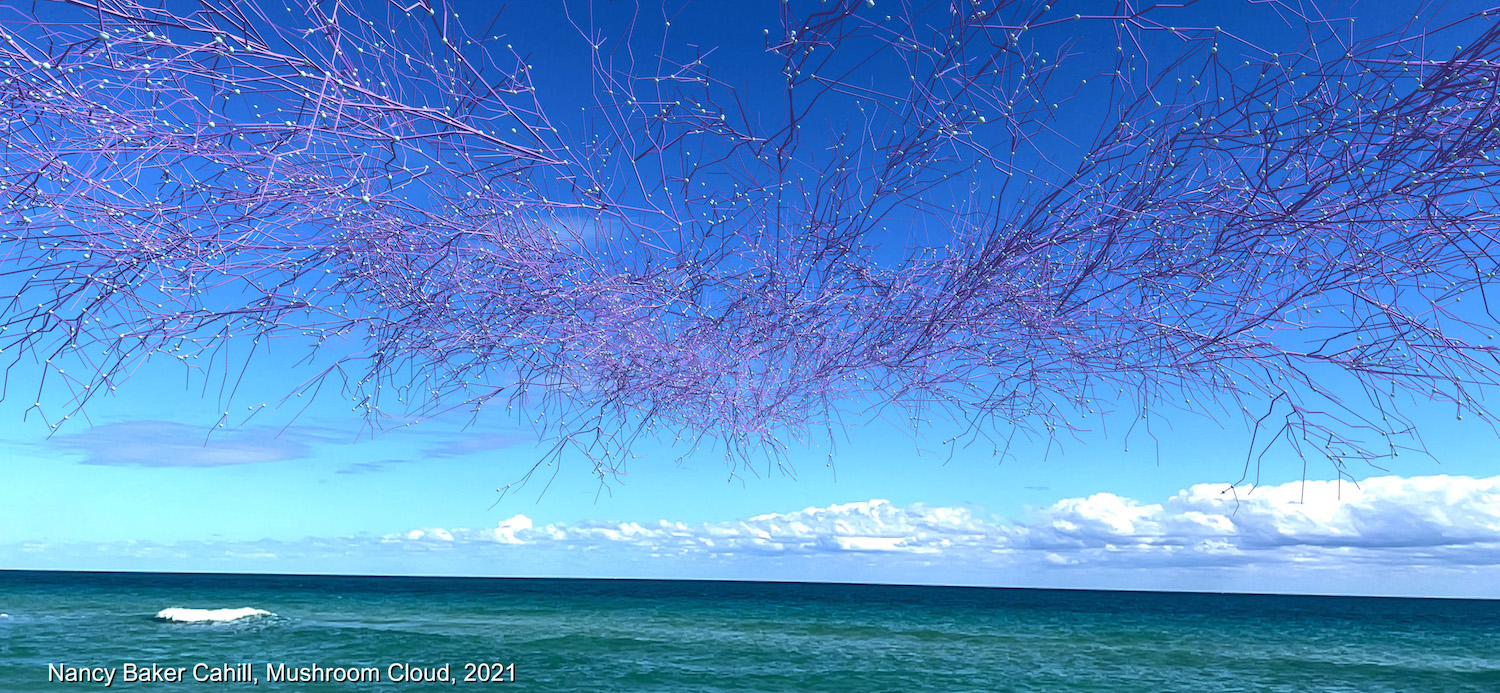
Mushroom Cloud Mycelia 2, 2021, augmented reality land art
When discussing her ongoing experiments with VR, AR and most recently Cinema 4D, Baker Cahill notes, “I think a lot about all the tools we have to play with reality creation. Part of the work is about what it means to manipulate reality, to mutate what is ‘known’ using all this …trickery.” While her work is undeniably attention-grabbing—due in part to its use of state-of-the-art technology and the ways it plays with fundamental principles of human perception—it also asks us to consider essential questions about how we create our own realities using information and tools that we don’t consciously control, from the internet code that determines how we engage in the emerging metaverse, to the biological constraints of the human retina. Hers is an art steeped in two worlds, the primordial world we inhabit in our flesh suits, and the new experiential digital infinite that awaits around an ever-narrowing corner. Whether you’re ready or not, this is the future. Are you ready?

